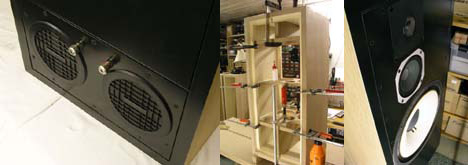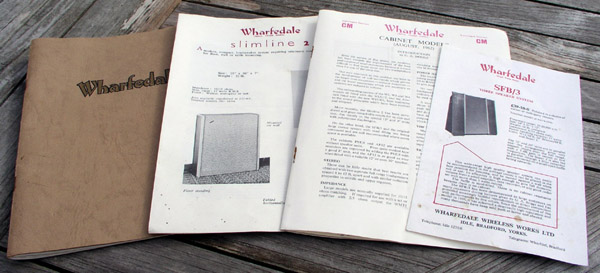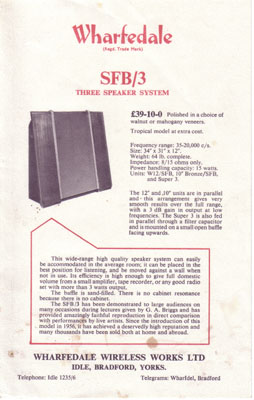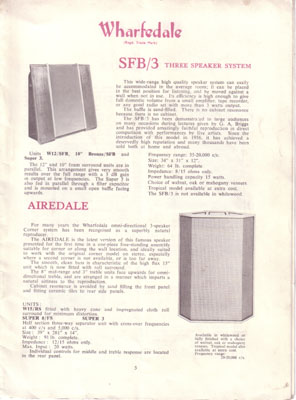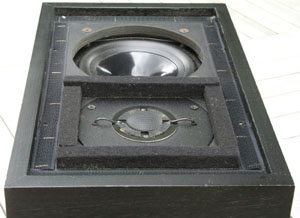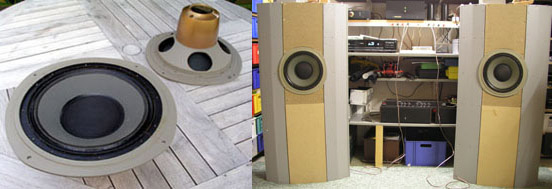Vintage
Loudspeakers
GREEN-CONES
SONAP
OA5
JBL
L100 CENTURY
JBL
LE20-25 TWEETERS
JBL
LE26 TWEETER
SPENDOR
BC1
Peoples' attitude towards vintage equipment is very different. To some people vintage gear is almost sacred and shouldn't be changed in any way. If it only has to me kept on the shelf, this is fine with me. If the equipment actually has to be used we may leave things as they are and not really enjoy the full potential of an e.g. speaker driver. It's like digging out an old Gran Torino from the barn and leave it rusty and dented and never again enjoy the ride as it once was. Like old cars, speaker drivers may need new/restored suspensions to work properly. I've seen vintage drivers with softened spiders lacking elasticity and resilience and being pretty much useless despite pristine cone and voice coil. Towards loudspeaker drivers - usually made by the thousands - my feeling of reverence is modest. As the saying goes: It takes three hifi nerds to change a light bulb, one to do it and two to discuss why the old one was better! Below and overview of some vintage hifi drivers and speakers I have bought over the years, mostly out of curiosity due to the enormous interest some of these items have acquired. Some of the drivers listed here have to my ears qualities that were not revealed in the constructions where they were used. This goes for the JBL drivers and the drivers used in the legendary Spendor BC1. The Philips 9710 full-range driver is totally nostalgia as this was one of the first quality drivers I had when I started getting interested in hifi back in the late Sixties. I hadn't heard the 9710 drivers for 3½ decades until recently, so would they live up to my expectations? German SABA
Greencones Reproduced music can be
enjoyed on many levels. I recall great moments from my
car stereo (first time I heard Renee Fleming) and many
years ago I remember a Danish violinist demonstrating the
difference of a "standard" violin and his
Stradivarious - this heard on a B&O
"transistor" radio! The difference between the
two instruments was striking, even from the 4-5"
oval in-built loudspeaker!
These speakers are quite good at
"making music in a room" - if you get my
meaning. Forget about pin-point imaging and the like.
Listening to the ever-lasting Jazz at the Pawnshop, all
the usual details of people speaking and rattling glasses
is pretty much gone. Overall the sound lacks bass and the
middle and upper treble is dominant and prevents you from
turning up the volume, which again will make the sound
even slimmer as we do need a certain loudness level to
energize the room. A drummer seriously hitting his
cymbals... let's be honest about the treble coming from 5
drivers in different locations, it just isn't good from
these speakers. JBL L100 Century
The James B. Lansing L100 Century studio-monitor became the best selling loudspeaker model of any company in the Seventies. 125,000 pairs were sold. By the end of the decade, recording studios in the US used more of JBL’s monitors than all other brands’ monitors combined. Due to the materials used, the L100 drivers are as good today as when they were produced, but the overall sound can be vastly improved by modern crossover technology. Go to website and read JBL-L100 Kit Details. Read about my L100 recreation in a new 65 litres aperiodic cabinet.
JBL LE20-1 and
LE25 tweeters
The LE20 is the early alnico cone tweeter from JBL followed by the LE25 having a slightly smaller membrane and ceramic magnet. The measurable performance of the JBL cone tweeters was steadily improved over the years as can be read from the articles on these three tweeters. JBL LE26 tweeters
Why can't I stop bidding on LE26 tweeters on eBay? 1. The LE26 is quite sensitive; average
SPL/2.8V is around 94 dB. From 6-15 kHz sometimes up to
96-97 dB/2.8V. Click heading to read more. Spendor BC1
I'm not sure which vintage speaker has the
most pages on the web, but the Spendor BC1 must be in the
top 10. I recently acquired a pair of these from Steven
Marsh, UK. Thanks Steve! This BBC monitor had been on my
wish list for a long time because it's a reference when
it comes to tonal neutrality and a smooth midrange. Does
the BC1 live up to its reputation? Goodmans Axiom
150 mkII In search for suitable drivers for an open
baffle 3-way, these Goodmans came up and I took my
chances and bought them. Buying vintage drivers on eBay
is gambling and in particular when we're talking drivers
some 40 years old; drivers having paper surrounds and
paper voice coil formers. Paper may over time take up
moisture and we run the risk of rubbing voice coils and
suspensions having lost compliance. TS-data may be way
off what they were back then. The drivers reported here
were so and so, but suitable for what I had in mind. Wharfedale Super
8/RS/DD, 10-15 ohms
Wharfedale Super
3 tweeters, 10-15 ohms
Wharfedale SFB, sand filled
baffle, approx. 1956
No, I do not have a pair of these speakers, but I would like to hear from someone who has. If any of these speakers are still around, please write and tell me about them. My friend Darryl has provided me with this old 1956 review. It's great fun reading this review of a speaker considered "retro" already at the time it was launched. 37 £ in 1956 for a pair. This way of making speakers is far from extinct. Download Wharfedale 1956 review, 800k pdf View some of the best images of the SFB I've been able to find. SFB pics and comments from owners More SFB pics here - from an eBay auction. New: Go to Wharfedale 1962 brochures/handouts download page. Karlson
Enclosure, 1955 Kindly sent to me by Bruce Bender,
US. Rogers LS35A, approx. 1975
I have a pair of Rogers LS3/5A for
reference, and I'm not going to report these in detail as
so much can be found on the web including all schematics.
It's even got a LS3/5A exclusive website http://www.ls35a.com/ Tannoy Monitor
Gold 15
The MG15s are a great experience. I had the good fortune to borrow four of these and two 100 liter cabs. I was told I hadn't heard the MG15s until 250 liter cabs were realised. Well, I didn't make 250 liter cabs but I did have some enjoyable weeks with these monster drivers before delivering them back. I didn't buy a pair. Click heading to read why. Tannoy Monitor
Gold IIILZ
A pair of Tannoy Monitor Gold IIILZ drivers were available on eBay and the price went too high, but I took my chances and I'm pleased with what I received. I was afraid these drivers would have a much too high Fs and not deliver any bass, but I was positively surprised when I mounted the drivers in the wide baffle cabs and finally again could hear that Tannoy sound after the 15" drivers had gone. YES, these drivers have a great midrange, they can play vocals so loud that most modern drivers are left far behind and they can make you feel the bass from a vented 90 litre cabinet - and they have that treble that make you jump in your seat when a drummer hits the snare drum hard. No, they are not aural nirvana - few speakers are - but they have qualities we just don't get these days from most modern loudspeakers. To the right the Tannoys in the wide baffle cabs. I had just routed for the new 12" bass drivers and the Tannoys just fitted in. Turning the cabinets upside down the sound wasn't bad at all! Read report on Tannoy MG IIILZ JBL L26, approx. 1973 I paid 400 DKK (65 US$) for these JBL L26
speakers and the bass drivers badly needed refoaming, so
this was a good opportunity to improve my skills in this
area. I'd never done such a big driver before, and thanks
to Speakerbits in Australia I got new foam surrounds and
started playing with the 125A bass drivers. This 10"
paper cone driver has to go all the way up to 2.5-3 kHz
where the LE25 tweeter takes over. Is this possible and
could JBL really make a speaker that just wouldn't be
"tizz-and-boom"?
Philips 9710
One evening, I was writing to a friend on
old hifi stuff and I mentioned the Philips 9710
full-range drivers. I took a quick look at eBay and there
they were. And not just there, but only a 100 km from
where I live. Couldn't believe it. Thanks to Kenneth in
Aalborg! I've been looking for these drivers for years
and years. A nice pair of 9710 drivers and price OK.
Actually I got an extra driver for free, so I had one for
experiments as an untreated paper surround really does
not stand against time when we are talking 40 years or
so. These surrounds did not have any resilience left and
you could place the cone wherever you liked in the magnet
gap. After the surrounds were coated with some very
dilute coating material, they regained performance and
they play better than you would expect. These drivers are
sensitive: 93-94 dB in the midrange and 100 dB from 2 kHz
up to 10-12 kHz. No wonder they could make a lot of noise
from a 2 x 5 W solid state amp or a mushy EL84 valve amp.
One of my friends bought these old SEAS
speakers for ~100 US$ and I had them for some days to
hear how they would perform and to see if an upgrade was
worthwhile. "As is" these speakers can be fine-tuned to a performance that leaves many modern speakers behind. Giving the tweeter the right polarity plus some further attenuation, the frequency response was reasonably flat and I'm almost stunned by the performance of these speakers: Dynamic, transparent, etc. This is "an-easy-to-listen-to" speaker. Clarion by SEAS,
70120
Nils-Åke/Sweden came by with these 1978 Clarion speakers. "Clarion by SEAS" the badge says. I have no idea about the financial set-up behind this speaker brand, but SEAS seems to have been involved in more than only producing the drivers. The speakers were in pretty bad shape and mid and bass drivers both had rotten foam surrounds and needed replacement. This speaker is some of the better vintage stuff - and I like it. The classic 3-way, here from a 10" bass driver (25 F-WBX/DD), the magnificent 11FM (H130) mid driver, and the so-and-so 1", H107 tweeter with polyamide dome. I had my reservations with regard to the dome, but in this application is does fine with a point of crossover above 5 kHz. To my eyes it's an elegant speaker with the sloped front panel and matching front grille. The veneer is excellent and with the narrow front fillets it makes a nice light-weight appearance; very Scandinavian and in the best tradition of some Danish furniture designs (Mogens Kock). Celestion HF1300
tweeter
This is a strange fellow. Works well from 1.5 kHz to 13 kHz. Sounds very good but needs flush-mounting like all tweeters. The cone has a very wide suspension and it may actually be the ancestor of the modern e.g. Vifa DX25TG tweeter. But who designed the housings and who got the idea for the turbo grille in front of the diaphragm? Do you know the story behind this design, please tell me. Martin Colloms has some details on the tweeter in his book. Excerpt at the BC1 page. |



